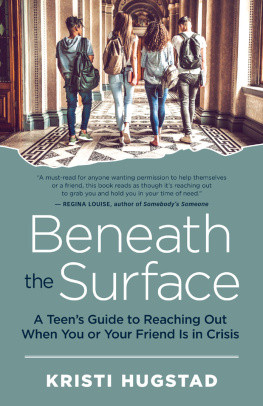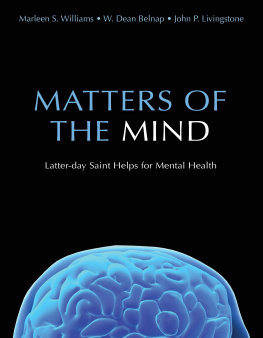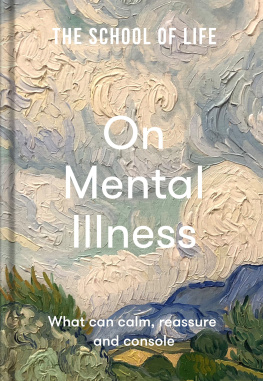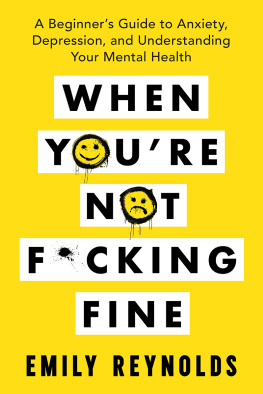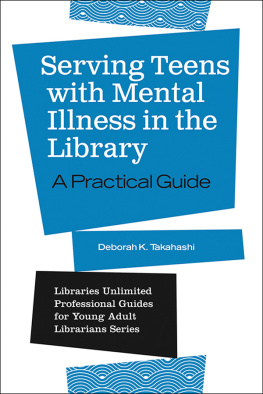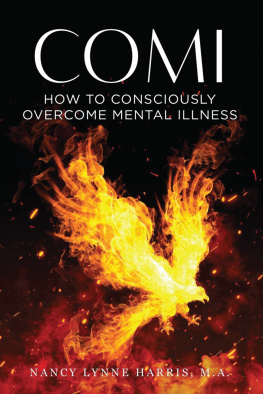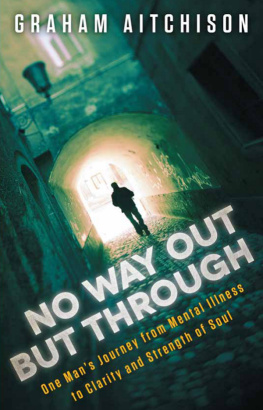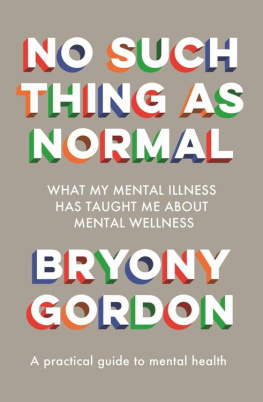
Writing this book was more rewarding than I ever could have imagined, as it empowered me to deliver a message of hope and help to those struggling most. As I continue every day to process the grief of losing my husband to suicide, I am buoyed up by the purpose Ive found in the wake of that tragedy.
To Bill: Thank you from the bottom of my heart for the good memories those that constantly motivate me to help those who are struggling as you were.
This book never would have been possible without Sheila Peterson, who believed in my mission and whose shared passion for mental health awareness and suicide prevention made this book a reality.
Im eternally grateful to Kristen Price and Juliet Ekinaka for their hard work and dedication. I couldnt ask for a better team.
To my mom, Val; my sisters, Deb, Viki, and Jen; and my brother, Todd: Thanks for all your support and encouragement.
To my agent, Paul Levine: Thank you for believing in me and in this book. Your dedication opened life-changing doors.
To the publishing team at New World Library: Georgia Hughes, editorial director; Kim Corbin, senior publicist; Kristen Cashman, managing editor; Tracy Cunningham, art director; and Tona Pearce Myers, production director; as well as Jeff Campbell, editor extraordinaire: Thank you for believing in my mission, and for helping me get this important book into the hands of those who need it most our nations teens.
To the teens reading this book: Thank you for the honesty, vulnerability, and faith youve shown simply by opening it. Please know that, along with everyone else who loves you, Im in your corner and wishing you the best.

Kristi Hugstad is on a mission to abolish the stigma of mental illness and suicide, and that starts with teens. Kristis husband, Bill, completed suicide by running in front of a train after struggling for decades with clinical depression and substance abuse. Their story may have ended differently if theyd known the warning signs and risk factors of depression and suicide, and today Kristi is determined to raise awareness of both, so no one is ever too late to save a loved one.
Kristi Hugstad is the author of What I Wish Id Known: Finding Your Way through the Tunnel of Grief and R U OK?: Teen Suicide and Depression. She is also a professional speaker, certified grief recovery specialist, grief and loss facilitator for addicts in recovery, and credentialed health educator. Kristi hosts The Grief Girl podcast and The Grief Girl OC Talk Radio show, and she is a longtime blogger for the Huffington Post and Elephant Journal. For more information, visit her website, www.thegriefgirl.com.

INTRODUCTION
1. How often do you, your friends, or your family members talk about suicide, depression, or mental illness?
2. What are some things in your life you feel you need to keep up with?
3. What would happen if you didnt keep up with these things?
4. Have you ever felt like you might have depression?
5. What are some ways social media makes you feel bad?
6. What are some ways social media makes you feel good?
CHAPTER 1: WHATS GOING ON IN YOUR BRAIN?
1. In what ways do teen brains differ from adult brains?
2. What are some reasons teens tend to be impulsive or reckless?
3. How do you think depression or mental illness can affect a teens developing brain?
4. Why do you think teens are more susceptible to peer pressure and substance abuse than adults?
CHAPTER 2: YOU ARE NOT ALONE
1. Have you ever known someone going through a hard time and didnt know how to react?
2. What are some ways you can support someone who is struggling or in crisis?
3. What are some ways that others have supported you when youve been upset or struggled?
CHAPTER 3: DEPRESSION
1. What is something new in this chapter that you learned about depression?
2. Why do you think that most people who complete suicide suffer from depression?
3. Did this chapters description of depression remind you of anyone (including yourself)? If so, in what ways?
Jackies Story
1. What are some things Jackie experienced that could cause or worsen depression?
2. What are some things you related to, or didnt relate to, in Jackies story?
3. What are some ways Jackie coped with her depression?
4. What could Jackie have done at a younger age to make her life better?
CHAPTER 4: EATING DISORDERS
1. Whats the difference between diet and exercise and an eating disorder?
2. How do you think eating disorders serve as a coping mechanism for other issues?
3. Do you or someone you know have the risk factors or exhibit the symptoms of an eating disorder? How might you help them?
CHAPTER 5: BULLYING
1. What is the difference between bullying and other altercations or arguments?
2. Why do you think victims of bullying are more likely to think about suicide?
3. Have you ever been bullied? Have you ever bullied someone else?
Caitlins Story
1. In your opinion, why didnt Sofia tell anyone about being bullied?
2. What are some of the warning signs of suicide Sofia exhibited?
3. If Sofia had been your friend, what would you have done to help?
CHAPTER 6: SELF-HARM
1. How is self-injury different than suicide or attempted suicide?
2. What are some reasons that people self-injure?
3. What are some of the warning signs or symptoms of self-injury?
4. Why is therapy and counseling so imperative for those who suffer from self-injury?
Kaleys Story
1. What social factors do you think influenced Kaleys self-injury?
2. Why do you think Kaley isolated herself from friends and family?
3. How did understanding self-injury empower Kaley to change?
CHAPTER 7: POST-TRAUMATIC STRESS DISORDER (PTSD)
1. Who suffers from PTSD?
2. How do you know if you have PTSD?
3. What are some of the risks of leaving PTSD untreated?
4. Who would you seek help from if you thought you had PTSD?
CHAPTER 8: PEER PRESSURE AND STRESS
1. What are some of the pressures you feel on a day-today basis?
2. Think about a time you gave in to peer pressure. What was your motivation?
3. How can the influence of peers be positive?
4. Why do you think some teens are more susceptible to peer pressure than others?
5. When have you ever found yourself doing something to please someone other than yourself?
6. What are some ways you can relieve stress?
CHAPTER 9: ANXIETY
1. Everyone gets anxiety now and then. What are some signs of an anxiety disorder?
2. Have you known anyone with an anxiety disorder? How did that affect his or her life?
3. Why are people with anxiety more likely to abuse drugs and alcohol?
4. What would you do if a friend or loved one showed signs of anxiety?
5. What are some ways you can curb anxiety?
Ashers Story
1. What or who were sources of pressure in Ashers life?
2. How did Ashers anxiety become a circular problem?
3. How did Ashers parents situation add to his anxiety?
4. Did therapy cure Asher? How did it help him cope?
CHAPTER 10: SUBSTANCE ABUSE
1. What are some of the warning signs of drug and alcohol abuse?
Next page
